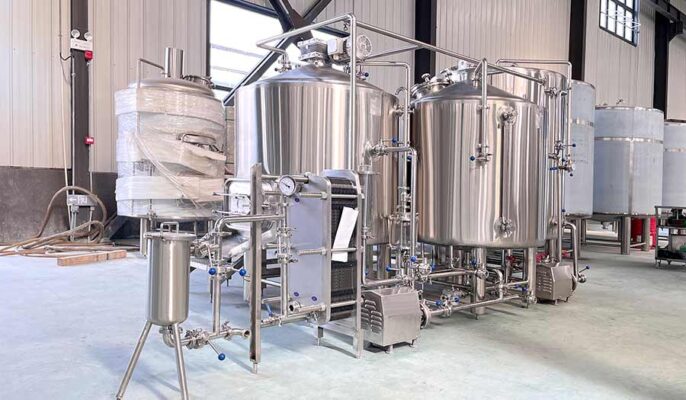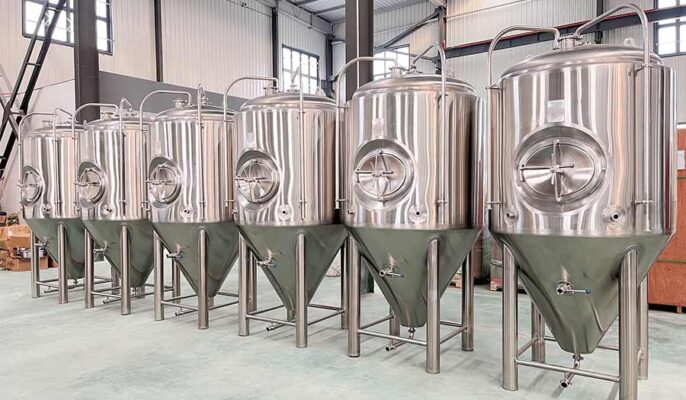There are many things to consider when opening a brewery, and the project is different for each type of brewery. There are still many things we need to know after starting a brewery. Knowing these questions and being able to answer them is a great first step in your quest to open a brewery. In this article, we’ll look at the elements that apply to most brewing projects and will be covered in the next round of discussions.
What containers does a brewery need?
Back to the original question, we discussed how many brewery containers you want. If it was a 4 vessel system then it would be a separate mash mash, lauter tun, kettle and whirlpool.
For a 3-vessel brewing system, there are two options. One is a combination of mashing and filtering, the other is a combination of kettle and whirlpool. Both combinations have their own advantages and disadvantages:
Mashing/Filtration Combination
When brewing , brewers often find that brewing time is shorter with this setup. Having separate kettles and whirlpools means you can start your second filtration as soon as your first brew goes into the whirlpool. Additionally, you can install a small heat exchanger between the kettle and the whirlpool. This makes it easy to add aroma hops to lower the temperature of the wort. Brewers get better results by adding aromatic hops to the cooler wort in the whirlpool.

Kettle/whirlpool combination
If you want to stage your mash, having a separate mash mixer means you have a more even mash temperature. With a combo mash filter, you tend to get temperature stratification. Additionally, it is easier to heat the mash for mashing. The mash is then transferred to the lauter barrel. Filter buckets are sized for thinner beds, better runoff and efficiency.
Even with a 2 vessel system, we have a choice:
- Option 1 – Three tanks for mashing/boiling, filtering and whirlpooling
- Option 2 – Three tanks for mash/filtration, HLT and kettle/whirlpool
Do you want a grain conveyor system?
This also usually depends on the size and budget of the brewery. I generally recommend against using a grain conveyor system if the system capacity is 800 liters or less. If your capacity exceeds 1,500 liters, then having a grain conveyor system is definitely a more suitable option. It saves labor hours, prevents injuries, and allows for better mash mixing based on the brewery design. Additionally, on larger systems, the type of grinder you choose to buy also becomes a consideration. When planning brewery production, the efficiency of the brewery becomes key. This means you may need to upgrade your malt grinder. While the cost of upgrading a malt grinder is high, you will recoup the cost over time.
Fermentation Vessel (FV) and Unitank Design
This isn’t a big deal, but most breweries these days choose to use unit tanks rather than dedicated fermenters. This also means you need to equip these unit tanks with carbide. The carbon fossil is usually placed above the cone inside the tank. Additionally, if space is at a premium, the tank may need to be “thinner.” Thus, you can fit as many tanks as you need into a small space to meet sales forecast capacity needs.
If you’re brewing a lot of hopped beers, you’ll need a dedicated and large enough hop port. Next, we discuss where you want the manhole, whether you want a side manhole or a top manhole. If you have a top manhole, you don’t always need a jump port.
Do you need a Bright Tank?
There are now some breweries that are choosing not to use BBT. They only use FV and the packages there. If you are a brewpub and sell everything on tap, this might be for you.
If you do prefer BBT, then a rule of thumb is to get 1 BBT for every 5 FV you have. This is a guide, the reality is that depending on your brewing style you may only need one BBT to brew 8 to 10 FVs.
What are the regulations in your country?
Some countries are stricter than others when it comes to steam. If you want to open a brewpub in an urban area, you may not be able to use steam heating due to health and safety regulations.
If you are in Australia, you will need AS1210 certification and a design registration number for the tank. If you plan to open a brewery in Europe, then you need CE certification. We will discuss this in a after discussion and identify the selected manufacturer and its circumstances.
Do you need a pilot system?
Having a pilot brewing system allows you to try out new brewing recipes or ingredients, helping you determine if it’s worth expanding to a larger brewing system for production.
Having a pilot allows you to have fun and brew some super niche beers to keep your “craft” customers happy without having to mass-produce them.

Can it be stored offsite?
Many of our customers are considering small-scale canning of beer in brewpubs. When you’re ready to start canning beer, a lot of empty cans can take up a lot of space. When opening a brewpub, you definitely want to provide the largest dining area for your customers. So, we often ask customers if they will store offsite.
warehouses will be set up near brewpubs, but in areas with cheaper rents. If you plan on canning beer, you’ll most likely need to hire a delivery driver. This also means you can transport the cans to the brewery for filling production when needed.
Need to filter?
small home brewers may not choose to filter their beers. But in a production brewery, you may need some form of separation technology, depending on the size of the brewery and the project budget. Micet will also help you explore all possibilities and choose the option that best suits your needs, please contact us if necessary.
Production and operation
Many customers often ask if we can help them install, get their brewery operational and train their team. Before, Micet engineers have helped install and commission some brewery projects in other countries. We will debug the equipment before it leaves the factory and mark numbers on the connected pipes. You only need to connect according to the data to complete the installation of the brewery equipment. Of course, if you have any questions, our engineers will provide you with solutions online. If necessary, communication can be conducted via video.
Besides, the Micet team also provides other types of services, such as brewing recipe development. If you have any questions, we can help you online . We can also help you create:
- Brewing schedule
- Production plan template
- It can also help calculate the cost of beer if needed
Create brewery follow-up questions
As the brewery’s follow-up questions kick off, start filling in some key details. There are many elements to opening a brewery, so it’s a process that takes time. It usually takes about 30 days from initial contact for equipment list to placing an order. This is a long process. We hope you will have the patience to discuss your brewery project with us. Micet can provide you with a complete turnkey solution and ensure it meets your needs.




